The cork tree is the only tree that has a bark that can regenerate itself after harvest without providing any damage to the tree or the environment. The cork tree is a variety of the hardy oak species. The bark of the cork tree grows so quickly that it can be harvested every six years. The tree is never killed or cut down and will produce harvestable bark for centuries, as shown in Figure 1. Very little, if any, of the harvested materials go to waste.

Figure 1 - Harvesting cork
Cork flooring is an excellent investment as a home improvement.
Figures 2 and 3 show cork trees after the bark has been harvested.
Cork flooring is beautiful, durability and its additional benefits, as explained below make it an ideal flooring choice for residential and commercial applications where it has been used for centuries. Table 1 provides a sample collection of different cork flooring.
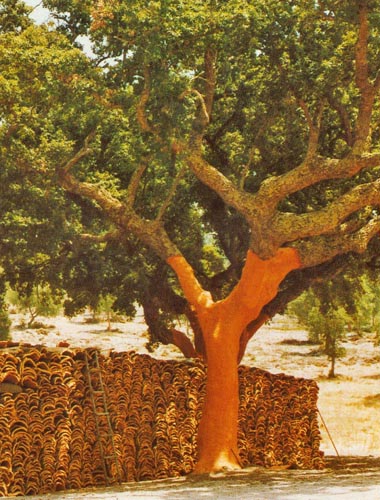
Figure 2 - Cork tree after harvesting
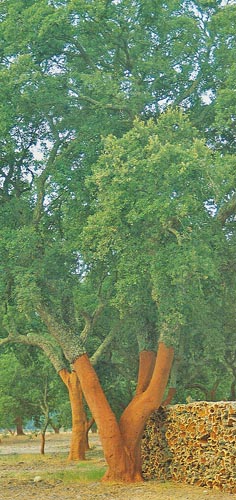
Figure 3 - Cork tree after harvesting
Cork makes a beautiful surface flooring but because of its negligible sound transfer characteristics it is often used under laminate and hardwood flooring, especially in high-rise condominiums and apartment buildings (where, in many cases, its use has been mandated) to reduce sound transfer to suits below. Cork underlayment provides some of the best noise-reduction characteristics available in today's home improvement and construction market.
Cork underlayment is available in roles and sheets in various sizes and thicknesses.
Additional information about the use of cork as an underlayment for flooring.
Table 1 - Selection Of Cork Flooring
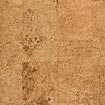
11mm x 305mm x 915 mm Cassatt Cork Flooring
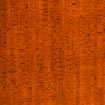
11mm x 305mm x 915 mm Goya Cork Flooring
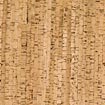
11mm x 305mm x 915 mm Matisse Cork Flooring
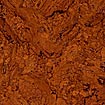
11mm x 305mm x 915 mm Miro Cork Flooring
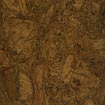
11mm x 305mm x 915 mm Monet Cork Flooring
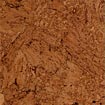
11mm x 305mm x 915 mm Van Gogh Cork Flooring
Durability and Resilience:
Even though cork is elastic and can be compressed it is a good choice if you are in the market for a durable flooring material. Many European homes built in the last century still have their original cork floors. Cork is considered to be a resilient flooring that will provide decades of service to a home or office. As with any hardwood flooring material, cork, in order to last, must be properly cared for.
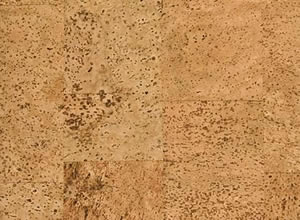
Figure 4 - Floor made with cork tiles
In kitchens and bathrooms it makes an excellent choice as the material of choice for flooring. Cork flooring is highly resistant to penetration by any liquid and it has a non-slip surface, depending on how it is finished. In kitchens and baths the seams of any floating cork floor should be sealed.
Health Benefits:
Because cork is naturally hypoallergenic in that it resists the growth of mildew and mold, it is wise choice for homeowners who are concerned about their family's health, as it is a perfect flooring choice if family members suffer from asthma or allergies. For people who may have respiratory problems cork is an antistatic material, it will not attract and hold pollen or dust particulate. Cork floors do not shed their fibers, meaning no flooring material dust and the are relatively easy to maintain.
Insulating Properties:
Warm to the touch even without any under-floor heating, cork has excellent insulation properties. Cork has a very low thermal conductivity, which helps to insulate floors from heat and cold making it an ideal flooring material for below grade cement subfloors especially bedrooms and basement family rooms. A properly installed cork floor will reduce heating and cooling costs, in effect paying for itself.
Cork absorbs vibration which in effect makes it a highly efficient sound barrier and crack suppression underlayment under hardwood or any other hard surface floor dramatically reducing the transmission of sounds from one floor to another. The commercial building industry has been using cork underlayment for years.
Application:
The installation of cork flooring is a project well within the capabilities of most home handymen. You can apply cork over any sub-floor, and you can apply it over nearly any existing flooring with the exception of carpet. In most installations of cork flooring it is wise to install 6 mil poly sheeting over the sub-floor to act as a moisture barrier.
